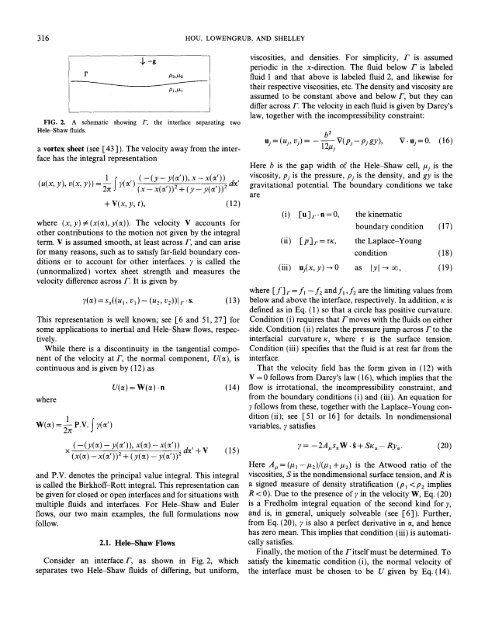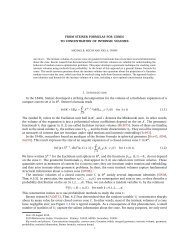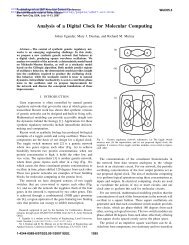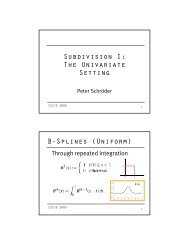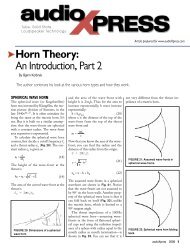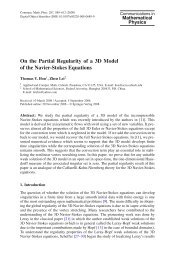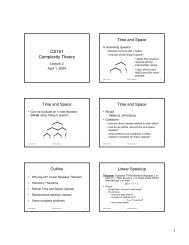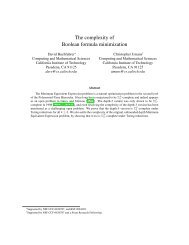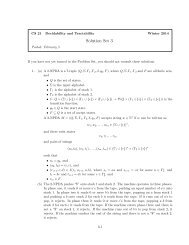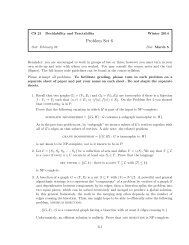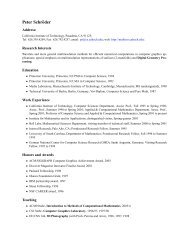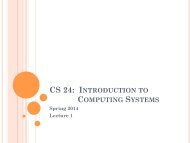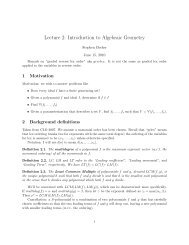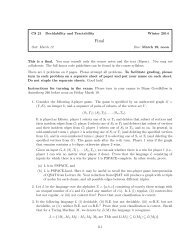FLOWS WITH SURFACE TENSION 315lower order terms in <strong>the</strong> evolution. There is also an equationanalogous to Eq. (8) for L. Such a reformulation of fluidinterface evolution, as in Eq. (11 ), is a "small scale decomposition."It is <strong>with</strong>in <strong>the</strong> small scale decomposition thatimplicit integration or linear propagator methods can beapplied to a high order linear term. With periodic boundaryconditions, <strong>the</strong>se methods are explicit in Fourier space andhave no high-order time step constraint. The time-steppingmethods are coupled to spectrally accurate spatial discretizations.Small scale decompositions are given also formore general Hele-Shaw flows and for interface flows under<strong>the</strong> Euler equations.An example of what is possible <strong>with</strong> <strong>the</strong>se methods is seenin Fig. 1, which shows <strong>the</strong> simulation of a gas bubbleexpanding into a Hele-Shaw fluid (see [ 15, 16]) over longtimes. From <strong>the</strong> competition of surface tension <strong>with</strong> <strong>the</strong> fluidpumping, this simulation shows <strong>the</strong> development oframification through successive tip-splitting events and <strong>the</strong>competition between adjacent fingers. This simulation isalso spectrally accurate in space and uses a second-order intime linear propagator method for integrating <strong>the</strong> smallscaledecomposition. There are no high-order time stepconstraints. The fluid velocity is calculated using <strong>the</strong> fastmultipole method [23], and GMRES [42] is used to solve<strong>the</strong> integral equation that arises <strong>from</strong> having a viscosity con-" trast [22]. The operation count is O(N) at each time-step,where N is <strong>the</strong> number of points describing <strong>the</strong> boundary.Here N= 4096, S = 0.001, and At = 0.001. The time step is103 times larger than that used by Dai and Shelley [ 16] incomputations of a similar flow using an explicit method15<strong>with</strong> a lesser number of points, and <strong>the</strong> interface here hasdeveloped far more structure.The organization of <strong>the</strong> paper is as follows. In Section 2,boundary integral formulations are given for <strong>the</strong> motion offluid interfaces under surface tension in both Hele-Shawand two-dimensional Euler flows. The interface is interpretedas a vortex sheet whose normal velocity is determinedby <strong>the</strong> Birkhoff-Rott integral. Its vortex sheetstrength is determined by <strong>the</strong> equations of motion andboundary conditions. In Section 3, <strong>the</strong> source of stiffness in<strong>the</strong>se problems is discussed and motivated by <strong>the</strong>generalized linear stability analysis of Beale, Hou, andLowengrub [10-12]. In Section4, <strong>the</strong> Birkhoff-Rottintegral is carefully examined. It is shown that this integral,asymptotically at small scales, becomes a Hilbert transformof <strong>the</strong> sheet strength over a flat interface, <strong>with</strong> a variableprefactor. In Section 5, <strong>the</strong> description of <strong>the</strong> interface isreformulated in terms of 0 and L. This step makes <strong>the</strong>variable coefficient depend only upon time, and at smallscales, <strong>the</strong> leading order terms are only nonlocal through aHilbert transform. This leads to small scale decompositionsfor <strong>the</strong> evolution problems. In Section 6, numerical methodsare discussed. This includes second-order integrationmethods that exploit <strong>the</strong> small scale decomposition toremove <strong>the</strong> high-order stiffness, generalizations to higherorder time discretizations, as well as o<strong>the</strong>r related numericalissues such as spectrally accurate spatial discretizations. InSection 7 <strong>the</strong> results of numerical simulations using <strong>the</strong>semethods are presented. These results include <strong>the</strong> motionof Hele-Shaw interfaces moving under <strong>the</strong> competinginfluences of gravity and surface tension, in addition to <strong>the</strong>expanding gas bubble. The roll-up and collision of vortexsheets <strong>with</strong> surface tension in an Euler flow is also given.Concluding remarks are given in Section 8.10-5-10-15-1I I I I I-10 -5 0 5 10 15Time =0 to 45FIG. 1.An expanding Hele-Shaw bubble.2. THE FORMULATIONIn this section, boundary integral formulations are givenfor two illustrative incompressible flows. The first describes<strong>the</strong> motion of an interface separating two Hele-Shaw fluidsof differing densities and viscosities. The second describes<strong>the</strong> motion of a vortex sheet in a two-dimensional, inviscidfluid. As <strong>the</strong> concept of a vortex sheet arises also in <strong>the</strong>Hele-Shaw case, this second case is referred to as an inertialvortex sheet.Consider an incompressible and irrotational velocity fieldin two dimensions given in terms of a velocity potential:(u,v)=V~. Suppose that ~b has a jump across aparametrized interface F= (x(~), y(0~)), but that its normalderivative is continuous (see Fig. 2). This implies that <strong>the</strong>velocity has a tangential discontinuity across F while <strong>the</strong>component normal to F is continuous (i.e., <strong>the</strong> kinematicboundary condition is satisfied). Such an interface is called
316 HOU, LOWENGRUB, AND SHELLEYP$-~pa,/z2FIG. 2. A schematic showing F, <strong>the</strong> interface separating twoHele-Shaw fluids.a vortex sheet (see [43 ] ). The velocity away <strong>from</strong> <strong>the</strong> interfacehas <strong>the</strong> integral representation(u(x, y), v(x, Y))1 f (--(y-y(og)),x-x(og)) , ,J ~(~') (x - x(¢)) ~ + (y- y(¢))= ao~+ V(x, y, t), (12)where (x,y)¢(x(oQ, y(ct)). The velocity V accounts foro<strong>the</strong>r contributions to <strong>the</strong> motion not given by <strong>the</strong> integralterm. V is assumed smooth, at least across F, and can arisefor many reasons, such as to satisfy far-field boundary conditionsor to account for o<strong>the</strong>r interfaces. 7 is called <strong>the</strong>(unnormalized) vortex sheet strength and measures <strong>the</strong>velocity difference across F. It is given by~(~)=s,((u,, v~)-(u2, v2))l~.s.This representation is well known; see [6 and 51, 27] forsome applications to inertial and Hele-Shaw flows, respectively.While <strong>the</strong>re is a discontinuity in <strong>the</strong> tangential componentof <strong>the</strong> velocity at F, <strong>the</strong> normal component, U(00, iscontinuous and is given by (12) aswhere1w(~) =~ P.V. f ~(~')U(~)=W(~).nviscosities, and densities. For simplicity, F is assumedperiodic in <strong>the</strong> x-direction. The fluid below F is labeledfluid 1 and that above is labeled fluid 2, and likewise for<strong>the</strong>ir respective viscosities, etc. The density and viscosity areassumed to be constant above and below F, but <strong>the</strong>y candiffer across F. The velocity in each fluid is given by Darcy'slaw, toge<strong>the</strong>r <strong>with</strong> <strong>the</strong> incompressibility constraint:b 2oj= (uj, vj) = 12ktjV(ps-psgy), V.uj= O. (16)Here b is <strong>the</strong> gap width of <strong>the</strong> Hele-Shaw cell, pj is <strong>the</strong>viscosity, pj is <strong>the</strong> pressure, Ps is <strong>the</strong> density, and gy is <strong>the</strong>gravitational potential. The boundary conditions we takeare(i) [U]r'n =0, <strong>the</strong> kinematicboundary condition (17)(ii) [ P ] r = zK, <strong>the</strong> Laplace-Youngcondition (18)(iii) uj(x,y)-~O as lyl---' ~, (19)where [ f ] r = fl - f2 and fl, f2 are <strong>the</strong> limiting values <strong>from</strong>(13) below and above <strong>the</strong> interface, respectively. In addition, x isdefined as in Eq. (1) so that a circle has positive curvature.Condition (i) requires that F moves <strong>with</strong> <strong>the</strong> fluids on ei<strong>the</strong>rside. Condition (ii) relates <strong>the</strong> pressure jump across F to <strong>the</strong>interfacial curvature x, where z is <strong>the</strong> surface tension.Condition (iii) specifies that <strong>the</strong> fluid is at rest far <strong>from</strong> <strong>the</strong>interface.That <strong>the</strong> velocity field has <strong>the</strong> form given in (12) <strong>with</strong>V = 0 follows <strong>from</strong> Darcy's law (16), which implies that <strong>the</strong>(14) flow is irrotational, <strong>the</strong> incompressibility constraint, and<strong>from</strong> <strong>the</strong> boundary conditions (i) and (iii). An equation for7 follows <strong>from</strong> <strong>the</strong>se, toge<strong>the</strong>r <strong>with</strong> <strong>the</strong> Laplace-Young condition(ii); see [51 or 16] for details. In nondimensionalvariables, 7 satisfies(- (y(0Q- y(0()), x(0Q - x(ct'))x (x(~) -x(~')) 2 + (y(~) - y(~,)12d~'+V (15)and P.V. denotes <strong>the</strong> principal value integral. This integralis called <strong>the</strong> Birkhoff-Rott integral. This representation canbe given for closed or open interfaces and for situations <strong>with</strong>multiple fluids and interfaces. For Hele-Shaw and Eulerflows, our two main examples, <strong>the</strong> full formulations nowfollow.2.1. Hele-Shaw <strong>Flows</strong>Consider an interface F, as shown in Fig. 2, whichseparates two Hele-Shaw fluids of differing, but uniform,7 = -2Aus~W. ~ + Sx~- Rye. (20)is <strong>the</strong> Atwood ratio of <strong>the</strong>viscosities, S is <strong>the</strong> nondimensional surface tension, and R isa signed measure of density stratification (Pl


